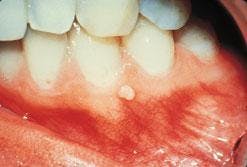by Joen Iannucci Haring
A 27-year-old male visited his family dentist for a routine checkup. The oral examination revealed a small lesion on the mandibular gingiva.
History
The patient first noticed the pale pink growth approximately one year earlier. When questioned about any change in size, color, or texture of the lesion, the patient stated that he was not aware of any changes. The patient denied any pain or discomfort associated with the lesion. No history of trauma to the affected area was reported by the patient.
At the time of the dental appointment, the patient appeared to be in an overall good state of health. The patient's medical history was reviewed; no significant positive findings were noted. At the time of the dental appointment, the patient was not taking medications of any kind. The patient's past dental history included regular dental examinations and routine dental treatment. The patient's last dental appointment was approximately 11/2 years earlier for a dental prophylaxis.
Examinations
Physical examination of the head and neck regions revealed no enlarged or palpable lymph nodes. The patient's vital signs were all within normal limits.
No significant extraoral findings were noted. Intraoral examination revealed an elevated, pale pink growth located on the attached gingiva in the area between teeth #21 and #22. The lesion appeared to be firm and measured approximately 2 millimeters in diameter. A slight papillary surface texture was noted.
The teeth adjacent to the lesion were pulp tested for vitality; both #21 and #22 tested vital. Further examination of the oral soft tissues revealed no other masses present.
The patient was referred to an oral surgeon for an excisional biopsy. Histologic examination of the tissue revealed numerous large stellate and multinucleated giant fibroblasts.
Diagnosis
Based on the clinical and histologic information presented, which one of the following is the most likely diagnosis?
o irritation fibroma
o peripheral ossifying fibroma
o peripheral giant cell granuloma
o retrocuspid papilla
o giant cell fibroma
Diagnosis
• giant cell fibroma
Discussion
The giant cell fibroma can best be described as a focal fibrous hyperplasia that is characterized by its distinctive histologic appearance. The giant cell fibroma may clinically resemble other common hyperplastic, connective tissue oral lesions such as the irritation fibroma or the peripheral ossifying fibroma.
The giant cell fibroma should not be confused with other lesions that include the words "giant cell" in their names — for example, the peripheral giant cell granuloma.
Clinical features
Although the giant cell fibroma may be seen at any age, it typically is seen in individuals under the age of 30. The giant cell fibroma is asymptomatic and may appear smooth and nodular or papillary. The color is normal for the location, usually pale pink. The lesion may be pedunculated or sessile.
The giant cell fibroma usually measures less than one centimeter in diameter and is most often found on the gingival; the mandibular gingiva is affected more frequently than the maxillary gingiva. Other locations that may be involved include the tongue and palate.
Diagnosis
When nodular in appearance, the giant cell fibroma may clinically resemble the irritation fibroma, the peripheral giant cell granuloma, or the peripheral ossifying fibroma. When papillary in appearance, the giant cell fibroma may resemble the squamous papilloma or the condyloma acuminatum.
Histologic examination of the lesion is necessary in order to establish a definitive diagnosis. When examined histologically, the giant cell fibroma appears as a hyperplastic connective tissue growth. Within this connective tissue, large stellate and multinucleated giant fibroblasts are seen.
Treatment
The giant cell fibroma is a connective tissue lesion; it is not contagious and does not have malignant potential. The giant cell fibroma does not disappear over time and requires surgical excision. Recurrence of this lesion is very rare.
Joen Iannucci Haring, DDS, MS, is a professor of clinical dentistry, Section of Primary Care, The Ohio State University College of Dentistry.







